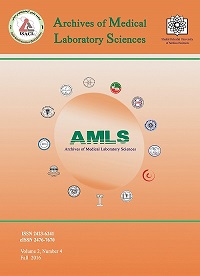Assessment of the ratio of cross-matched to transfused blood amounts in pregnant patients in Alzahra Hospital in Tabriz before and after the implementation of the health reform program in 2013-2015
Archives of Medical Laboratory Sciences,
Vol. 2 No. 4 (2016),
16 April 2017
https://doi.org/10.22037/amls.v2i4.17182
Abstract
Background: Postpartum hemorrhage is the most common cause of mortality in women with vaginal or cesarean delivery. WHO statistics shows that about 500 thousands women have died of complications related to pregnancy or during childbirth in 2013. haemorrhage probability is the main reason to order blood requests in delivery and cesarean units. The purpose of this study is to evaluate the ratio of cross-matched to transfused blood in pregnant women during one year before and after the implementation of health reform program.
Materials and Methods: In this retrospective descriptive study, the requests of blood reserves for pregnant patients with the gravid of 34±7 weeks and the age of 30±16 years old in two periods, before and after the implementation of health reform program were being collected and compared. Blood group antiserums and anti-human globulins with bovine albumins were purchased from LORN company and Baharafshan Company respectively.
Results: The total number of requests for reserved cross-matched blood during the year before the health reform program were 2837 units which 277 of them had been transfused and a year later the total number of requests was for 3029 units, which 270 of them had been transfused. This study showed 6.76 percent increase in requests and 2.53 percent decrease in transfusion in comparison with its past year.
Conclusion: The implementation of health reform program have accompanied by relative reduction of cesarean but considerable increase in vaginal delivery, and to prevent blood loss complications, the requests for reserved cross-matched blood have been increased without noticeable change in the proportion of necessarily transfused amount of them.
- Postpartum Haemorrhage
- cesarean section
- Albumins
- Pregnancy
- Health care reform
How to Cite
References
John R Smith et al, Post Partum Haemorrhage, College of Obstetrician and Gynaecologists, a web – based article; 2013.
Blood Transfusion in Obstetrics , NO.47, December 2007, minor revision 2008, royal college of obstetrician and gynaecologists.
Toby L, Edward L, BjarteG. Rossi’s Principles of Transfusion Medicine, Fourth edition, pages: 406-18.
Alao"dolei H, Kashizadeh M, Seddighian F. Evaluation of blood use in Babul yahyanegad hosp. Jour of Blood. 1387;5(2):133-7.
Efraim K. Blood conservation in South Africa. A vital need. Bloodless Medicine and Surgery. 2001;43:7.
Vibhute M, Kamath SK, Shetty A. Blood utilization in elective general surgery cases: requirements, ordering and transfusion practices. Postgrad Med. 2000;46:13-7.
Annexes to developing a national policy and guidelines on the clinical use of blood-recommendations. Transfusion Today. 1999;38:3-6.
Scope of blood transfusion in obstetrics, Subhayubandyopadhyay, inewells Hospital, Dundee, UK.
John D, Brenda J. Technical Manual, 17th edition, 2011.
- Abstract Viewed: 489 times
- PDF Downloaded: 225 times
